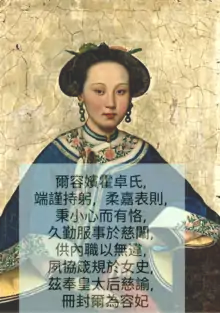Rong Fei
Rong Fei (容妃) or Consort Rong was an Uyghur minority woman who became a favorite consort to the Qianlong Emperor. Neither Manchu nor Han Chinese, her upbringing was different and she also walked a separate path from other consorts in the palace. The real Rong Fei was completely different from the fictional "Fragrant Consort".
Rong Fei (容妃) | |
|---|---|
He Zhuo (和卓氏) | |
| Born | October 11, 1734 Uyghur Hetian region, China |
| Died | May 24, 1788 Beijing China |
| Resting place | Yuling Consort Mausoleum |
| Other names | Consort Rong |
| Spouse(s) | Qianlong Emperor |
Background
Rong Fei (容妃) was one of the favorite consorts of the Qianlong Emperor. Her story changed over time, transforming her into a fictional character Xiang Fei around the early 1920s. Movies and TV series were made about the fictitious Fragrant Consort. The fiction was very different from historical facts. There was no Qianlong consort called the Fragrant Consort (香妃).

The actual Rong Fei (容妃) was a consort of Qianglong in his later years. Her progression in the palace was well documented in different official records. She was from an important Uyghur clan family named He Zhuo (和卓) which helped Qianlong in quelling rebellions. They were from the Uyghur Hetian region and were bestowed gifts and honors by the Emperor. Her father was ranked as a Qing Protectorate nobleman.[1] She was beautiful but 26 and previously married when taken into the palace as Noble Lady (贵人) under the tutelage of the Empress Dowager. The next year she was titled Noble Concubine (贵嫔), the 6th rank imperial consort title. Both the Emperor and Empress Dowager favored and trusted her. Two years later she was inducted as Concubine Rong and officially recorded in the title ceremony decreed by the Dowager Empress. Her brother was also honored with a higher rank at that time. [2]
In the 33rd year of Qianlong's reign, she became Consort Rong in similar ceremony the next day. She never climbed higher in the consort hiarchy. But her actual position continued to ascend within the palace. She often went on the southern and eastern expeditions. In later years the higher ranking consorts died and Qianlong often did not replace them to the point that there was no Empress from his 31st reign year. Her seating at the formal banquets continued its way to the head.[3][4][5][6]
History
She accompanied the Emperor on his 4th southern expedition with other consorts in his 30th reign year. He decreed imperial gifts for her on 80 occasions during the trip. The gifts included many ruyi scepters , agate drinking vessels in addition to exotic food and jewelry. She went on several expeditions and numerous gifts were recorded each time.[5]

The Emperor entirely redecorated the Bao Yue Lou Pavilion for her within the Forbidden City. She could live there and take respite from the palace consort compound. And looking down to the South she could see the Moslem community in Beijing. She had a full retinue there including a Moslem kitchen and chefs, tailors for her native dress and other Moslem attendants. There was a large portrait of her in the hall. She was indulged, but likely with purpose. Qianlong developed a keen interest in the Uyghur tribes which cost him 4 distant campaigns to pacify. He acquired a working knowledge of the Uyghur language, inscribing 4 Castiglione battle paintings in Manchu, Chinese, Mongolian and Uyghur.[7] The Emperor ordered the construction of a mosque in the Moslem area within sight of Bao Yue Pavilion. Upon completion in 1764, he wrote the dedication in the same 4 languages above. Rong Fei could help the Emperor with the Uyghur language.[8]
Rong Fei's portraits were used as references of The fictional Fragrant Consort. Due to her fragrant smell, she was known as the Fragrant Consort. The Emperor placed a large portrait of Rong Fei in Bao Yue Pavilion, which is on the south side of the lake in the Summer Palace. It overlooks Changan Road 长安街 which bisects Beijing today. The pavilion itself was converted about 1912 to be the main entrance structure for Zhongnan Hai which now houses the heart of the PRC central government.
Titles
- Official rank :
- Qianlong reign
- 25th year 2/4 Noble Lady (贵人)
- 27th year 5/21 Concubine Rong (容嫔)[1]
- 33rd yr 10/26 Consort Rong (容妃)
References
- Twenty Five Chronicles - Qing. 二十五史 清史稿. Qing Chronicles Empress Consort section 1. 清史稿 后妃传列传一: Shanghai Guji Press. -. 上海古籍出版社. 1986. ISBN 7-5325-0464-6.CS1 maint: location (link)
- Biographical Dictionary of Chinese Women - The Qing Period. (in English). Hong Kong University Press. 1999. ISBN 978-962-209-482-6.
- The Queen's of China 中国皇后全传(第3版). The Contemporary World Press. 2018. ISBN 978-7509014042.
- "Qianlong's Officially Recorded Consort - 乾隆皇帝正式册封的第一宠妃". China Daily. 2016.
- Liu Li. 刘力 (2008). Qianlong. 乾隆传. https://books.google.com/books?: Beijing Book Co. Inc. ISBN 9787999037996.
- Biographical Dictionary of Chinese Women: The Qing Period 1644-1911. Sydney University Press. 2010. ISBN 978-1920899516.
- Curtis, Emily Byrne (2019). Chinese-Islamic Works of Art, 1644–1912: A Study of Some Qing Dynasty Examples. https://m.barnesandnoble.com/w/_/_?ean=9781000752793: Routledge. pp. Chapter: A. Muslim Consort. ISBN 9781000752793.CS1 maint: location (link)
- 钦定日下旧闻考. This is a comprehensive compendium of Beijing places and events 北京地方志 commissioned by Qianlong in 1788: Beijing Guji Publishers. 北京古籍出版社. 2001.CS1 maint: location (link)